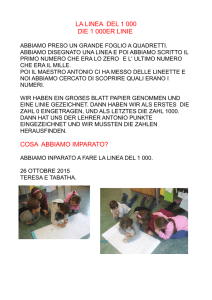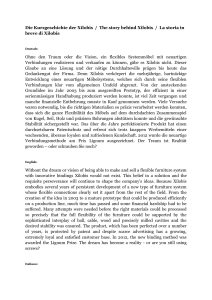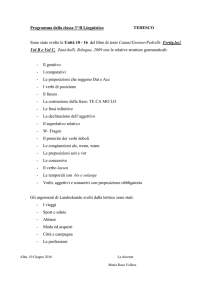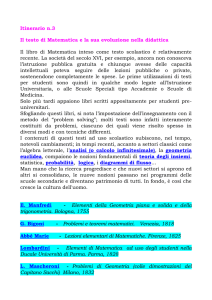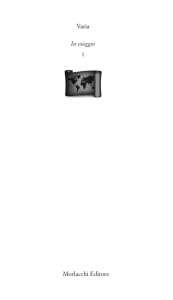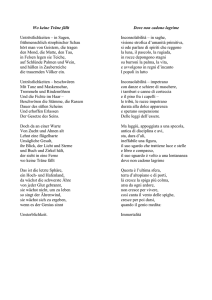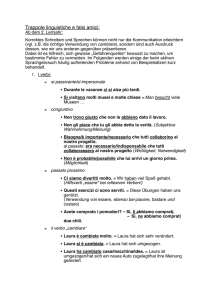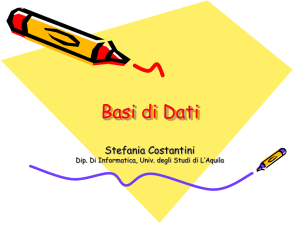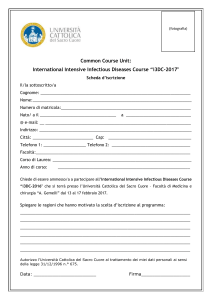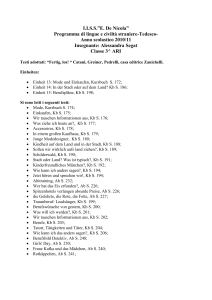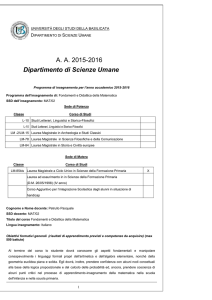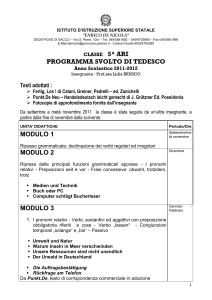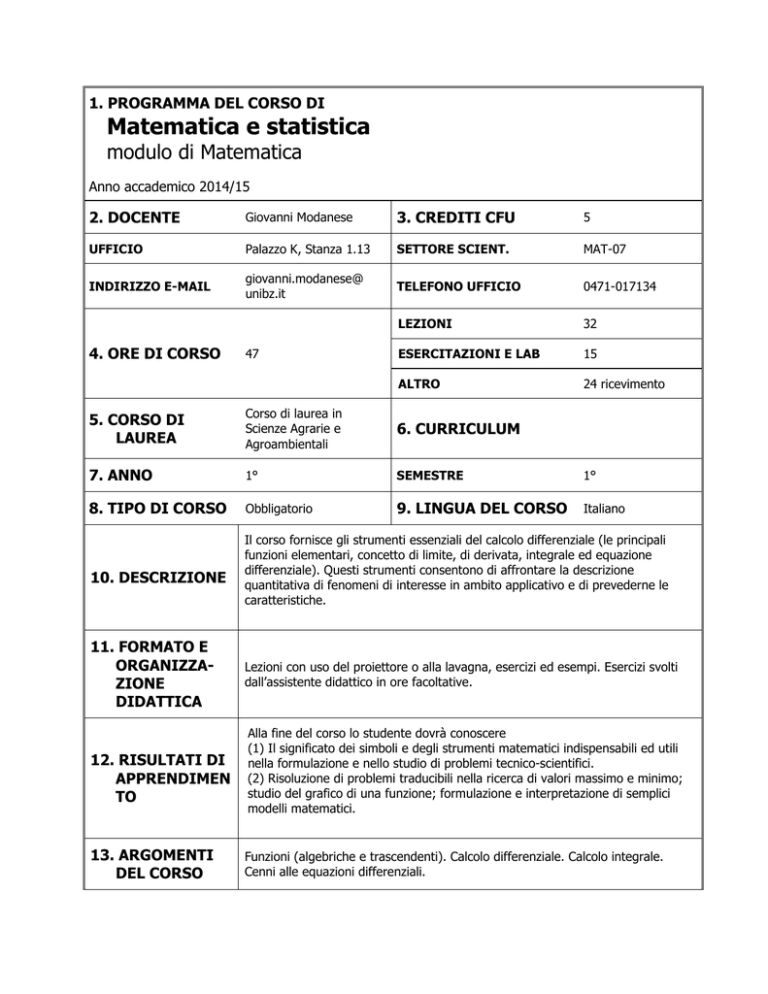
1. PROGRAMMA DEL CORSO DI
Matematica e statistica
modulo di Matematica
Anno accademico 2014/15
2. DOCENTE
Giovanni Modanese
3. CREDITI CFU
5
UFFICIO
Palazzo K, Stanza 1.13
SETTORE SCIENT.
MAT-07
INDIRIZZO E-MAIL
giovanni.modanese@
unibz.it
TELEFONO UFFICIO
0471-017134
LEZIONI
32
ESERCITAZIONI E LAB
15
ALTRO
24 ricevimento
4. ORE DI CORSO
47
5. CORSO DI
LAUREA
Corso di laurea in
Scienze Agrarie e
Agroambientali
6. CURRICULUM
7. ANNO
1°
SEMESTRE
1°
8. TIPO DI CORSO
Obbligatorio
9. LINGUA DEL CORSO
Italiano
10. DESCRIZIONE
11. FORMATO E
ORGANIZZAZIONE
DIDATTICA
12. RISULTATI DI
APPRENDIMEN
TO
13. ARGOMENTI
DEL CORSO
Il corso fornisce gli strumenti essenziali del calcolo differenziale (le principali
funzioni elementari, concetto di limite, di derivata, integrale ed equazione
differenziale). Questi strumenti consentono di affrontare la descrizione
quantitativa di fenomeni di interesse in ambito applicativo e di prevederne le
caratteristiche.
Lezioni con uso del proiettore o alla lavagna, esercizi ed esempi. Esercizi svolti
dall’assistente didattico in ore facoltative.
Alla fine del corso lo studente dovrà conoscere
(1) Il significato dei simboli e degli strumenti matematici indispensabili ed utili
nella formulazione e nello studio di problemi tecnico-scientifici.
(2) Risoluzione di problemi traducibili nella ricerca di valori massimo e minimo;
studio del grafico di una funzione; formulazione e interpretazione di semplici
modelli matematici.
Funzioni (algebriche e trascendenti). Calcolo differenziale. Calcolo integrale.
Cenni alle equazioni differenziali.
14. BIBLIOGRAFIA
DI BASE
M. Abate, Matematica e Statistica. Le basi per le scienze della vita, McGraw-Hill,
ISBN 9788838664922
G. Naldi, L. Pareschi, G. Aletti, Calcolo differenziale e algebra lineare, McGrawHill, ISBN 9788838663024
15. STUDENTI
AMMESSI
Studenti regolarmente iscritti al primo anno di corso.
16. RACCOMANDAZIONI
Frequenza del pre-corso di matematica in settembre.
17. VALUTAZIONE
DELLO
STUDENTE
Prova scritta. Per superare l’esame di Matematica e Statistica è necessario
ottenere, oltre una media pesata (peso statistica 4, matematica 5) di almeno
18/30, almeno 15/30 in entrambi i moduli.
1. COURSE SYLLABUS OF
Mathematics and Statistics
module: Mathematics
Academic year 2014/15
2. PROFESSOR
G. Modanese
3. ECTS CREDITS
5
OFFICE
Building K, Room 1.13
SCIENTIFIC FIELD
MAT-07
E-MAIL ADDRESS
Giovanni.modanese@u
nibz.it
OFFICE PHONE
0471-017091
LECTURES
32
EXERCISES AND LABS
15
4. COURSE HOURS
40
OTHERS
5. STUDY
PROGRAMME
Bachelor in Agricultural
and Agroenvironmental sciences
6. MAJOR IN
7. YEAR
1st
SEMESTER
1st
8. PROGRAMME
STATUS
Core
9. COURSE
LANGUAGE
Italian
10. DESCRIPTION
The course provides the essential tools of differential calculus (the main
elementary functions, concept of limit, derivative, integral and differential
equation). These tools can be used for the quantitative description of
phenomena of interest in agricultural science.
11. TEACHING
FORMAT and
ORGANIZATION
Lessons with use of the projector or the blackboard, exercises and examples.
Exercises done by the teaching assistant teaching in optional hours.
12. LEARNING
OUTCOMES
At the end of the course the student should know:
1. The meaning of symbols and mathematical tools necessary and useful in the
formulation and study of technical and scientific problems.
2. How to solve problems which require the search for maximum and minimum
values; study graph of a function, formulation and interpretation of simple
mathematical models.
13. TOPICS
Functions (algebraic and transcendental). Differential calculus. Integral
calculus. Basic concepts on differential equations
14. BASIC
BIBLIOGRAPHY
M. Abate, Matematica e Statistica. Le basi per le scienze della vita, McGrawHill, ISBN 9788838664922
G. Naldi, L. Pareschi, G. Aletti, Calcolo differenziale e algebra lineare, McGrawHill, ISBN 9788838663024
15. ELIGIBILITY
First year enrolled students
16. RECOMMANDATIONS
Attendance of the mathematics pre-course in September
17. STUDENT
ASSESSMENT
Written test. In order to pass the exam of Mathematics and Statistics the
student must obtain a weighted average (weight 4 statistics, mathematics 5)
of at least 18/30 and at least 15/30 in both modules.
1. Kurslehrplan
Mathematik und Statistik
Modul: Statistik
Akademisches Jahr 2014/15
2. DOZENT
Armin Schmitt
BÜRO (Lage)
Gebäude K, Raum 2.13
E-MAIL ADRESSE
[email protected]
4. LEHRSTUNDEN
5. STUDIENGANG
7. JAHR
8. KURSSTATUS
10. KURZBESCHREIBUNG
11. LEHRFORMAT UND
KURSORGANISATION
12. LERNZIELE
3. KREDITPUNKTE
WISSENSCHAFTLICHES FELD
TELEFONNR. BÜRO
SECS/S-02
0471-017138
VORLESUNGEN
24
ÜBUNGEN UND
LABORSTUNDEN
16
ANDERE
12
Bachelor in
Agrarwissenschaften
und
Umweltmanagement
1.
4 von 9
6. SCHWERPUNKT
SEMESTER
1.
Deutsch; bei Bedarf
9. KURSPflichtfach
Zusammenfassung auf
SPRACHE
englisch
In diesem Kurs werden die wichtigsten statistischen Konzepte, die für ein
quantitatives Verständnis der Lebenswissenschaften notwendig sind,
eingeführt. Gleichzeitig werden die Grundzüge des kostenfreien Statistikpakets
R vorgestellt, so dass das Lösen statistischer Probleme mit realen oder
simulierten Daten eingeübt werden kann. Besonderes Gewicht wird auf die
graphische Darstellung von Daten gelegt. Für die wichtigsten Fachausdrücke
werden die englischen Begriffe vorgestellt.
Die Themen werden zunächst in den Vorlesungen – weitestgehend mit Tafel
und Kreide – behandelt und dann zeitnah am PC mit dem statistischen Paket R
eingeübt.
Am Ende des Kurses sollten die Teilnehmer in der Lage sein:
1.
eigene Daten zu erheben und zu speichern
2.
eigene Daten statistisch aufzuarbeiten und graphisch darzustellen
3.
wissenschaftliche Ergebnisse und Schlussfolgerungen kritisch zu
beurteilen
4.
das statistische Programmpaket R anzuwenden
16. EMPFEHLUNGEN
Der Kurs beinhaltet folgende Themen (Auswahl):
1. Deskriptive Statistik (Lagemaße, Streumaße)
2. Beurteilung von Daten; Erkennen von Ausreißern
3. Verteilungen
4. Graphische Darstellung von Daten
5. Kreuztabellen
6. Statistische Hypothesentests (z.B. T-test, Wilcoxon-test, Chi-QuadratTest)
7. Korrelationen
8. Grundzüge der linearen Regression
Skripten auf der Kurswebseite
Studenten, die im ersten Jahr des Bachelors “Agrarwissenschaften und
Umweltmanagement” eingeschrieben sind. Weitere Interessenten in
Abstimmung mit dem Dozenten.
Die Teilnehmer sollten über ausreichende Deutschkenntnisse verfügen und
Interesse an den quantitativen Aspekten der Lebenswissenschaften haben.
17. LERNERFOLGSBEWERTUNG
Schriftliche Prüfung am Ende des Kurses. Eigene Aufzeichnungen, Skripten und
sonstige Literatur sowie Taschenrechner dürfen benutzt werden.
13. THEMEN
14. BASISLITERATUR
15. ZUGANGSVORAUSSETZUNGEN
1. COURSE SYLLABUS OF
Mathematics and Statistics
module: Statistics
Academic year 2014/15
3. ECTS
CREDITS
2. PROFESSOR
Armin Schmitt
OFFICE
E-MAIL ADDRESS
Building K, Room 2.13
[email protected]
4. COURSE HOURS
5. STUDY
PROGRAMME
7. YEAR
8. PROGRAMME
STATUS
10. DESCRIPTION
11. TEACHING
FORMAT and
ORGANIZATION
12. LEARNING
OUTCOMES
13. TOPICS
14. BASIC
BIBLIOGRAPHY
40
SECS/S-02
0471-017138
LECTURES
24
EXERCISES AND LABS
16
OTHERS
12
Bachelor in
Agricultural Science
and agroenvironmental
sciences
1.
Compulsory
SCIENTIFIC FIELD
OFFICE PHONE
4 of 9
6. MAJOR IN
SEMESTER
1.
9. COURSE
LANGUAGE
German; if necessary
summaries in English
In this course the most important statistical concepts that are necessary for a
quantitative understanding of the life sciences will be introduced. At the same
time the fundamentals of the free statistical programme package R will be
introduced so that the solution of statistical problems by means of real or
simulated data can be practised. Special emphasis will be put on the graphical
visualization of data. For the most important terms the English translation will
be presented.
The topics will first be developed on the blackboard and then be deepened on
the PC using the statistical package R.
By the end of the course, students should be able to:
1. to acquire and handle their own data
2. analyse statistically and represent visually their own data
3. review critically scientific results and conclusions
4. apply the statistical programming package R
The topics of this course include:
1. Descriptive statistics (measures of location and dispersion)
2. Assessment of data; identification of outliers
3. Distributions
4. Graphical visualization of data
5. Contingency tables
6. Statistical hypothesis tests (e.g. t-test, Wilcoxon-test, Chi-square-test)
7. Correlations
8. Fundamentals of linear regression
Scripts on the course web page
15. ELIGIBILITY
16. RECOMMANDATIONS
17. STUDENT
ASSESSMENT
Students regularly enrolled in the first year of the Bachelor Study Programme
“Agricultural and Agro-Environmental Sciences”. The participation of further
interested students has to be discussed with the professor.
The participants should have a fair command of German and should be
interested in the quantitative aspects of the life sciences.
Written exam at the end of the course. Own documents, scripts and other
literature as well as pocket calculators can be used.

